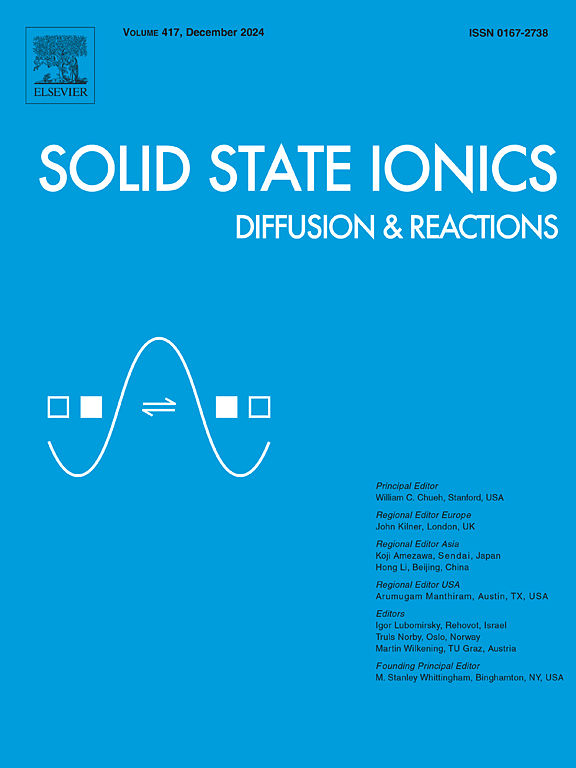通过过渡金属掺杂和外溶提高Zr0.1Ce0.9O2-δ的催化性能
IF 3.3
4区 材料科学
Q3 CHEMISTRY, PHYSICAL
引用次数: 0
摘要
Zr0.1Ce0.9O2-δ (ZDC)具有优异的储氧能力、较高的热稳定性和抗积碳能力,是一种具有成本效益的贵金属材料替代品,在工业催化中发挥着至关重要的作用,包括汽车尾气处理、固体氧化物燃料电池和碳氢化合物的催化燃烧等应用。优化Zr0.1Ce0.9O2-δ催化剂性能的重要新方法是原位溶出金属纳米颗粒。Exsolution被认为是在催化剂载体上产生高度分散的纳米颗粒,提高催化活性和稳定性的一种有前途的策略。本文将过渡金属阳离子(Fe, Co, Ni和Cu离子)掺杂到ZDC萤石结构氧化物(ZDCM)中,并在还原条件下(ZDCM- r, M = Fe, Co, Ni和Cu)在其表面析出。x射线光电子能谱和拉曼光谱证实,Co和Cu的析出在载体表面形成富氧空洞层,显著增强了其催化性能。结果表明,zdcu - r和ZDCCo-R催化剂都能在低于200℃的温度下实现完全的CO氧化。此外,zdco基阳极在800℃下的最大功率密度为348.2 mW,并且在固体氧化物燃料电池中直接利用甲烷时表现出优异的稳定性。本文章由计算机程序翻译,如有差异,请以英文原文为准。
Enhancement of catalytic performance in Zr0.1Ce0.9O2-δ through transition metal doping and exsolution
As a cost-effective alternative to noble material, Zr0.1Ce0.9O2-δ (ZDC) plays a crucial role in industrial catalysis, including applications such as automotive exhaust treatment, solid oxide fuel cells, and the catalytic combustion of hydrocarbons, due to its excellent oxygen storage capacity, high thermal stability, and resistance to carbon deposition. An important new approach for optimizing the performance of Zr0.1Ce0.9O2-δ as a catalyst is the in-situ exsolution of metal nanoparticles. Exsolution is recognized as a promising strategy for generating highly dispersed nanoparticles on the catalyst support, enhancing catalytic activity and stability. Herein, transition metal cations (Fe, Co, Ni and Cu ions) are doped into the ZDC fluorite-structured oxides (ZDCM) and exsolved on its surface under reduction conditions (ZDCM-R, M = Fe, Co, Ni and Cu). X-ray photoelectron spectroscopy and Raman spectroscopy confirm that the exsolution of Co and Cu generated an oxygen-vacancy-rich layer on the support surface, which significantly enhanced their catalytic performance. As a result, both ZDCCu-R and ZDCCo-R catalysts were able to achieve complete CO oxidation at temperatures below 200 °C. Moreover, ZDCCo-based anodes have shown a maximum power density of 348.2 mW at 800 °C and demonstrated exceptional stability during direct methane utilization in solid oxide fuel cells.
求助全文
通过发布文献求助,成功后即可免费获取论文全文。
去求助
来源期刊

Solid State Ionics
物理-物理:凝聚态物理
CiteScore
6.10
自引率
3.10%
发文量
152
审稿时长
58 days
期刊介绍:
This interdisciplinary journal is devoted to the physics, chemistry and materials science of diffusion, mass transport, and reactivity of solids. The major part of each issue is devoted to articles on:
(i) physics and chemistry of defects in solids;
(ii) reactions in and on solids, e.g. intercalation, corrosion, oxidation, sintering;
(iii) ion transport measurements, mechanisms and theory;
(iv) solid state electrochemistry;
(v) ionically-electronically mixed conducting solids.
Related technological applications are also included, provided their characteristics are interpreted in terms of the basic solid state properties.
Review papers and relevant symposium proceedings are welcome.
 求助内容:
求助内容: 应助结果提醒方式:
应助结果提醒方式:


